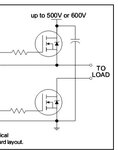sam781
Full Member level 4
@KlausST:
Thanks for your suggestion.... Here is my comments -
I used 10uF Tantalum capacitor (C1) for bootstrap voltage.
Actually, the waveform picture shared in post#19 is without transformer. Bridge output with and without transformer has been shared below with more clarity -
Without transformer-

With transformer-

With transformer connected with the bridge output, MOSFETs are becoming hot gradually.
- - - Updated - - -
While running the converter, I took the follwoing waveform -

Thanks for your suggestion.... Here is my comments -
I'll replace 1k resistor with 10k or 22k.Why R3, R4 are 1k?
Try 10k or higher.
Then you don´t need that huge 100uF capacitor for bootstrap voltage (although not wrong... You need well chosen electrolytic capacitors for 50kHz)
I used 10uF Tantalum capacitor (C1) for bootstrap voltage.
Picture in post#19:
It seems the transformer is saturating.
timing of scope seems to be 5us/div. If so ... saturation begins after 6us (rapidly increasing current, high power dissipation) .
twice 6 us = 12 us --> try PWM freq with 80kHz or more.
Actually, the waveform picture shared in post#19 is without transformer. Bridge output with and without transformer has been shared below with more clarity -
Without transformer-

With transformer-

With transformer connected with the bridge output, MOSFETs are becoming hot gradually.
- - - Updated - - -
While running the converter, I took the follwoing waveform -


